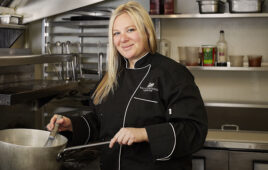We live in interesting and difficult times. Since Covid changed the world and the workforce, many industries have struggled to properly staff. Foodservice and hospitality have been uniquely affected—staffing has always been difficult, but now we’re dealing with an even more depleted workforce and inflation’s effect on wages. Many businesses have had a hard time adjusting—payrolls continue to push higher and, at some point, it becomes untenable to carry a dramatically higher payroll with the same output. For many industries, the answer to these issues is automation.
Is this also the answer in our world?
Let’s first define automation. For this, I’ll take a bit wider view of it and include things like self-checkout at the grocery store. It’s not automation per se, but it goes with the general theme of the rise of technology. After that, we have to identify tasks or processes that can be automated, specifically in a private club. Using self-checkout as an example, ordering kiosks are being used in fast food increasingly, but it’s tough to imagine that becoming the norm at a club. Sure, many clubs use web ordering for takeout and such, but it’s done more for convenience than to reduce the workload of service staff. This is where things get a little tricky to measure.
What can we automate in a club kitchen? What pressures does this alleviate? What are the benefits? What reduction in labor can be expected? These are the key questions. By and large, tasks that can be automated fall into two primary categories: mundane prep tasks like knifework and cooking tasks. Things that can’t be automated are the more high-touch items like plating, building salads, or other otherwise customizable items. This is a major sticking point.
When we look at technology in industries that are already highly automated, one thing is immediately apparent—these machines really only do one simple thing. They repeat one task very efficiently, over and over again. Unlike humans, they don’t get tired, don’t need breaks, etc. This works well in high-volume manufacturing for one simple reason: scale. It’s the next evolution of Henry Ford’s assembly line. Instead of repeatedly paying a human being to do one simple thing, we’ve created machines to do it, allowing for higher output, lower labor costs, and more profitability. Foodservice and hospitality are unique, and particularly in clubs, scale isn’t on our side. Just think of the wide array of tasks a cook must complete in a standard shift. We switch tasks nearly constantly all day long. That is very difficult to automate. We have news here that is simultaneously good and bad—no robot can do a cook’s job right now.
I’ll let you decide how you feel about that.
The good news is that there is a rise in technology being developed for kitchens. Generally, this technology raises productivity, reduces the need for skill in some instances, helps create consistency, and improves efficiency. All of this combined may help with labor in two ways—by lowering necessary skills, the upward trend in cooks’ wages may cool off. Secondly, by improving efficiency and making it easier to cook better food, you may be able to operate with slightly less manpower in peak volume periods. Neither of these is to say that you can expect to reduce your staff size by 20%. With the nature of clubs being intimate, high-touch, custom experience-driven environments, technology can only serve to support that—not replace it.
What are some available technologies that are driving efficiency in the modern kitchen?
- Combi Ovens
- Prep machines
- Automated kettle/braiser units
- Pressure cooking functionality
- Programmable fryers
- Belt ovens
- Pizza Equipment
Let’s start with combi ovens. These have been around for a while. I think most of us have seen them and probably love them. You have an “oven” that offers full fan and humidity control to offer completely customizable cook settings. These ovens also have a “brain” and can execute a cooking process with a probe inserted into the food item. You hit a button or two and walk away. It automatically sears the prime rib, cooks it to the perfect temperature, then goes into a hold setting until you’re ready to serve it—you don’t have to keep stopping to temp the rib or leave a pot of something boiling over on the stove because you ran away in a panic realizing you lost track of time. You put a hotel pan of liquid eggs in; the door opens midway through the cooking process for you to stir them. At the end of the cooking cycle—perfectly fluffy scrambled eggs, you didn’t have to stand over a stove or tilt skillet stirring them the whole time. You preheat a grill pan, throw marinated chicken breasts on it, insert a probe and walk away. While doing something else, your chicken breasts are being cooked to the perfect temperature, and an alarm will sound when they’re done. The combination (combi) oven is the biggest staple in modern kitchens. They raise overall productivity, improve quality and consistency, and make it easier for chefs to serve better food. They’re a thing of beauty. But you’re probably not eliminating positions when you add that new combi oven, though you might be able to get a little more done in less time. This is a great example of doing more with less on peak days.
When I say “Prep Machines,” I’m referring to a pretty broad class of equipment aimed at simple tasks such as slicing or dicing, wedging lemons, etc. Your waitstaff may have a lemon wedger near the iced tea station. Maybe they use it because they need a lot of lemon wedges. Maybe they don’t because they hate having to clean it. There’s quite a spread of these types of machines, from the simple and relatively inexpensive Matfer Prep Chef to the far more advanced Piper GSM 5 Star Food Processor, these machines cut down the amount of time needed for basic slicing and dicing.
With the wages cooks are making in today’s economy, it’s worth considering the value of these machines—if you need a lot of onions sliced or tomatoes diced, you probably don’t want to pay a cook $20+ an hour for that task. These machines can help with that, but they have their limitations. For one, these machines excel with large volume needs. If you’re in a large volume operation where you need 4-5 gallon buckets of onions sliced or tomatoes diced daily, then you absolutely should look into machines like these. The problem in clubs, as I mentioned earlier, is scale. We tend to need cooks to complete a wide variety of tasks, not necessarily a huge volume of any of them, and that makes for a problem when using these machines. The improved efficiency doesn’t quite show when you’re making a 1/6th pan of pico de gallo, or you need grated cucumber for 3 quarts of tzatziki. To go with that, your cooks might find these machines a nuisance, as they’ll seemingly be spending more time cleaning the machine and switching blades than anything else.
A really exciting category of technology is automated kettle and braiser units. Examples would be the Rational iVario and the Firex Cucimix. These are two decidedly different units with specifically different technology, but they have some overlap. The iVario offers automated processes like cooking pasta for you. Load pasta in the basket; it drops into the water, cooks via timer, and the machine lifts the pasta out when the timer says to. No more overcooked pasta. The Cucimix allows you to program recipes and cooking steps. The unit stirs your product for you, prompts you to add product as needed, and cooks the recipe for you. You can prepare large batches of bechamel and never have to worry about burning the roux, or make large batches of pastry cream and never wind up with a clumpy mess because you got distracted. Both of these units cook via a probe and offer very precise controls. Again, this is technology that will make it easier for chefs to serve better food. You’ll be more productive when you’re busy, but you’re probably not cutting positions because you were able to add this unit to your kitchen. These units are not small investments, going for around $25k for starting iVario units, up to $100k or more for Cucimix depending on the size and functionalities.
Pressure cooking functionality is something I’m really excited about seeing added to commercial cooking equipment. I have long lamented the limitation on the size of pressure cookers. I enjoy making seasonal jams and condiments, but large canners generally work fine for this. I absolutely love them for making apple butter in a matter of hours. I’ve long enjoyed using them to make full-flavored stocks with full gelatin extraction in a matter of hours instead of a full day or so. Again, enter the iVario and the Cucimix. Veal stock with full flavor and impressive gelatin content in 4 hours instead of a full 24-hour cook time. Beans in about 8 minutes. Rice in 12. The question isn’t what you should pressure cook, but what can you pressure cook? Short ribs, stews, curries, etc. Not to mention the stocks—good Lord, stock production like this is the stuff chefs dream of! This is another instance like the ones above—equipment like this will allow increased capabilities, increased productivity, and improved efficiency when busy, but not likely a reduction in baseline staffing levels. Pressure cooking functionality can add thousands in cost to iVario or Cucimix units.
Programmable fryers, once scoffed at by many chefs including myself, are increasingly becoming worth considering. As labor budgets tighten due to rising wages, necessitating cooks to do more, these fryers are growing in relevance. For instance, just hit a button to cook chicken tenders in a motorized basket that automatically raises them at the preset time. The same goes for French fries in another basket. This technology is particularly helpful if your fry cook also manages the pantry, easing many headaches. While making a salad, taking instructions, and answering a server’s question, you won’t risk burning fries or undercooking chicken tenders. During busy times, productivity, quality, and efficiency are all maximized with such technology. However, it’s important to note that while this technology can maximize efficiency when busy, it’s unlikely to reduce baseline staff. But, fryers are expensive, astonishingly so when considering high-end models with features like programmability and filtration, with each fryer bay costing upwards of $15,000.
Belt ovens, a broader category that includes TurboChef variants, offer significant opportunities to streamline cooking processes, though they may require some engineering work. You might be surprised by what can be cooked in a belt-fed oven, which may use impingement and/or microwaves to expedite cooking. This technology drives much of what Master Chef Rich Rosendale does in one of his new concepts.
The biggest concern is how this integrates with the customization required in a club. Chefs will need to thoroughly understand the equipment and develop dishes to maximize their potential. These ovens are not minor investments, ranging from $8,000 to over $30,000, but they offer potential staff streamlining depending on menu engineering.
I remain somewhat skeptical about significant baseline staff reductions in a club setting.
Lastly, pizza equipment encompasses a wide range. This includes new pizza oven models like the Woodstone OneRev and automatic dough press machines. Being delicious, trendy, and profitable, pizza requires more skill than it seems. Skilled pizza making is not a task for just anyone, as shaping dough and timing the oven is challenging. Woodstone’s recent oven release theoretically manages heat as the pizza makes exactly one revolution around the heat source, eliminating the need for timed rotations. This technology simplifies the pizza station, reducing the skill needed and helping to control labor costs.
While the aforementioned automation technologies like combi ovens, prep machines, and programmable fryers offer significant benefits in improving efficiency and reducing skill requirements in foodservice, particularly in club settings, they cannot fully replace the versatility and craftsmanship of human cooks. These innovations serve more as a support to enhance productivity and quality rather than a means to substantially reduce staffing levels, reflecting a balance between technological advancement and the intrinsic value of human touch.



